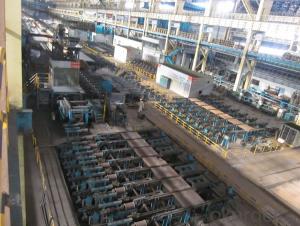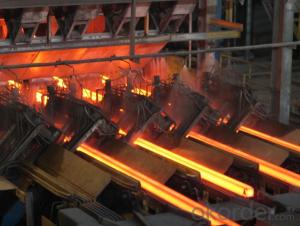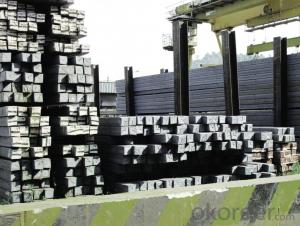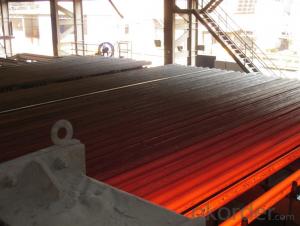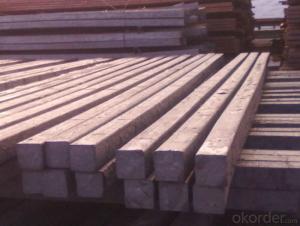Prime Q275 95mm Square Alloy Steel Billet
- Loading Port:
- Shanghai
- Payment Terms:
- TT OR LC
- Min Order Qty:
- 100 m.t.
- Supply Capability:
- 10000 m.t./month
OKorder Service Pledge
OKorder Financial Service
You Might Also Like
Structure of Prime Q275 95mm Square Alloy Steel Billet

Description of Prime Q275 95mm Square Alloy Steel Billet
1. Prepainted steel coil is coated with organic layer, which provides higher anti-corrosion property and a longer lifespan than that of galvanized or galvalume steel sheets.
2. The base metals for prepainted steel coil consist of cold rolled, HDGI Steel, electro-galvanized and hot-dip alu-zinc coated steel. The finish coats of prepainted steel coil can be classified into groups as follows: polyester, silicon modified polyesters, polyvinylidene fluoride, high-durability polyester, etc.
3. The production process has evolved from one-coating-and-one-baking to double-coating-and-double-baking, and even three-coating-and-three-baking.
4. The color of the prepainted steel coil has a very wide selection, like orange, cream-colored, dark sky blue, sea blue, bright red, brick red, ivory white, porcelain blue, etc.
5. The prepainted steel coils can also be classified into groups by their surface textures, namely regular prepainted sheets, embossed sheets and printed sheets.

Main Feature of Prime Q275 95mm Square Alloy Steel Billet
Uncoated CR steel sheet
With the features of in line with the international highest standards in demension and shape, excellent surface finish and properties, the products are mainly used in home appliance and automobile industries.
Galvanized steel sheet(include HDG and EG)
With the features of good corrosion resistance, the products are mainly used in automobile, home appliance, electronics, building and machinery manufacture industries, etc.
Precoated steel sheet
With the features of enviromental protection and good processablility, long lasting surface durability, rich in colors, the products are maily used in building, home appliance and furniture industries, etc.
Applications of Prime Q275 95mm Square Alloy Steel Billet
A. Corrugated design makes it excellent waterproof performance
B. Materials as prepainted steel sheets, galvanized steel sheets, galvalume (Al-Zn coated sheets) are available to make corrugated sheet.
C.Those material are durable, anti-corrosion in bad weather for 20-30 years based on it's Zinc(Galvanized) coating or AZ (Galvalume) coating.
D. Different shape of the sheet make it suitable for any style of buildings.
E.Easy to install, no need special tools to fix the sheet.
F.Light weight due to high strength to weight ratio of steel. Light weight means easier handling lower shipping costs, easier installation
G. Different color is availbe base on the RAL Standard make your building more beautiful.
H. We will provide the best solutions if you don't have a exact idea of the specification you want for the steel sheet based on your weather conditions, engineering structure, construction budget and so on.

Specifications of Prime Q275 95mm Square Alloy Steel Billet
Product | Billet |
Material Grade | SGCC / SGCH / DX51D+AZ, etc |
Thickness | 0.6-3.0mm |
Width | 500-1500mm |
Tolerance | Thickness: +/-0.02mm , Width:+/-2mm |
Zinc-coating | Z30-150g/m2 |
Technique | Raw material: Hot rolled steel coil --> Cold rolled_>hot dipped galvalume |
Surface | Dried, Chromated, Unoiled |
Spangle | Regular spangle , small spangle, zero spangle |
ID | 508MM 610MM |
Coil weight | 1-25MT |
Export package | Cardboard inner sleeves, Waterproof paper, galvanized steel covered and steel strip packed |
FAQ of Prime Q275 95mm Square Alloy Steel Billet
We have organized several common questions for our clients,may help you sincerely:
1. How Can I Visit There?
Our company is located in Tianjin City, China, near Beijing. You can fly to Tianjin Airport Directly. All our clients, from home or aboard, are warmly welcome to visit us!
2. How Can I Get Some Sample?
We are honored to offer you sample.
3. Why choose CNBM?
Our delivery time about 15-20days for standard sizes, if you have other requirements like hardness, quanity and width ,it is about 20-40days. But don't worry we also try our best for the delivery time ,because time longer and our cost is higher.
- Q:What is the average lifespan of a steel billet in a structural application?
- The average lifespan of a steel billet in a structural application can vary depending on various factors such as the quality of the steel, environmental conditions, maintenance practices, and the specific structural application. However, with proper care and maintenance, steel billets can generally have a lifespan of several decades or even longer in structural applications.
- Q:What are the international standards or certifications for steel billets?
- Steel billets are subject to various international standards and certifications, which guarantee their quality, safety, and compliance with industry regulations. One widely recognized standard is the ISO 9001 certification, which establishes criteria for a quality management system. This certification ensures that steel billet production adheres to international quality standards and consistently meets customer requirements. In addition to ISO 9001, the steel industry has other specific certifications. The ISO 14001 certification focuses on environmental management systems, ensuring that steel billet production follows sustainable practices. This certification demonstrates a commitment to minimizing environmental impact and promoting sustainable development. Another crucial certification is the ISO 45001, which emphasizes occupational health and safety management. This certification verifies that steel billet manufacturers have implemented effective safety protocols and procedures to protect employees and prevent workplace accidents. Moreover, the American Society for Testing and Materials (ASTM) establishes standards for steel billets, such as ASTM A615/A615M for deformed and plain carbon-steel bars used in concrete reinforcement. These standards outline mechanical properties, chemical composition, and testing methods for steel billets used in construction applications. Similarly, the European Committee for Standardization (CEN) sets standards for steel billets through the European Norm (EN) system. For example, EN 10025 specifies technical delivery conditions for structural steel products, including steel billets, used in various European industries. Adhering to these international standards and certifications is crucial for steel billet manufacturers. It ensures the quality, safety, and compliance of their products. Conforming to these standards not only enhances the manufacturer's credibility and reputation but also provides customers with confidence that the steel billets they purchase meet the highest industry standards.
- Q:Can steel billets be used in the production of construction machinery?
- Yes, steel billets can be used in the production of construction machinery. Steel billets are semi-finished products that can be further processed to manufacture various components and parts required in construction machinery. These billets provide a reliable and strong material, making them suitable for the construction industry's heavy-duty applications.
- Q:How are steel billets classified based on their chemical composition?
- Different grading systems can be used to classify steel billets based on their chemical composition. One commonly used method involves categorizing the billets into three main groups: low carbon steel billets, medium carbon steel billets, and high carbon steel billets. Low carbon steel billets typically contain less than 0.25% carbon and are known for their excellent ductility and weldability. They are often used in applications that require good formability and low strength, such as construction materials and automotive components. Medium carbon steel billets, on the other hand, have a carbon content ranging from 0.25% to 0.60%. These billets offer improved strength and hardness compared to low carbon steel billets and are commonly used in applications that require higher strength, such as machinery parts, shafts, and gears. High carbon steel billets have a carbon content greater than 0.60% and are recognized for their exceptional strength and hardness. They are commonly used in applications that demand high wear resistance, such as cutting tools, springs, and knives. In addition to carbon content, the presence of other chemical elements in the steel billets can also impact their classification. Elements like chromium, nickel, and molybdenum, known as alloying elements, can enhance the properties of the steel, such as corrosion resistance or heat resistance. Steel billets can therefore be further classified based on the specific alloying elements present and their concentrations. Overall, classifying steel billets based on their chemical composition allows for a better understanding and selection of the appropriate material for specific applications. This ensures that the desired properties and performance of the final product are achieved.
- Q:How do steel billets contribute to the overall vibration resistance of a product?
- Steel billets are an essential component in enhancing the overall vibration resistance of a product. The high-strength properties of steel make it an ideal material for reducing vibrations and improving product stability. Steel billets are typically used as a raw material in the manufacturing process, where they are further processed into various shapes and forms. The dense and uniform structure of steel billets allows them to absorb and dissipate vibration energy effectively. When integrated into a product, steel billets provide additional mass, which helps dampen vibrations by absorbing and distributing the energy throughout the structure. This mass acts as a stabilizing force, preventing excessive movement and reducing the amplitude of vibrations. Moreover, steel billets possess excellent mechanical properties, such as high tensile strength and stiffness, which contribute to the overall vibration resistance of a product. These properties enable steel billets to withstand dynamic forces and resist deformation under vibration, ensuring the structural integrity of the product. Additionally, steel billets can be engineered to have specific geometries and cross-sectional shapes that further enhance their vibration resistance. For example, the use of round or square billets with smooth surfaces minimizes stress concentration points and reduces the risk of fatigue failure. By optimizing the design and dimensions of steel billets, manufacturers can tailor the vibration resistance of a product to meet specific requirements. In summary, steel billets play a crucial role in improving the overall vibration resistance of a product. Their high mass, dense structure, and superior mechanical properties enable them to absorb and dissipate vibration energy, stabilize the product, and enhance its structural integrity. By utilizing steel billets in the manufacturing process, manufacturers can ensure that their products are more resistant to vibrations, leading to improved performance and longevity.
- Q:How are steel billets used in the manufacturing of railway wagons?
- Steel billets are used in the manufacturing of railway wagons as they serve as the raw material for various components such as frames, side panels, and undercarriages. These billets are first heated and then shaped into the desired form through processes like rolling or forging. The resulting components are strong, durable, and able to withstand the rigorous demands of railway transportation, ensuring the safety and reliability of the wagons.
- Q:How are steel billets cut to size?
- Steel billets are typically cut to size using various methods such as sawing, torch cutting, shearing, or using automated machines like bandsaws or plasma cutting machines.
- Q:How are steel billets used in the production of industrial furnaces?
- Steel billets are an essential component in the production of industrial furnaces. These billets, which are semi-finished steel products, serve as the raw material for manufacturing various furnace components. To begin with, steel billets are used to fabricate the furnace shell or casing, which provides the structural integrity and containment for the furnace. The billets are shaped and welded together to form a sturdy and durable outer shell that can withstand the high temperatures and harsh conditions within the furnace. Moreover, steel billets are used to construct the furnace doors and access panels. These components need to be strong and resistant to deformation and warping caused by the intense heat generated inside the furnace. By using steel billets, manufacturers can ensure that the doors and access panels can be opened and closed easily, while maintaining their structural integrity over time. Furthermore, steel billets are also utilized in the production of furnace grates and supports. These components are responsible for holding and supporting the materials being heated inside the furnace. By using steel billets, manufacturers can create robust and heat-resistant supports that are capable of withstanding heavy loads and high temperatures for extended periods. In addition, steel billets are often used in the fabrication of heat exchangers within industrial furnaces. Heat exchangers are vital for transferring heat from the combustion chamber to the materials being processed. The use of steel billets ensures that the heat exchangers have excellent thermal conductivity and can withstand the corrosive effects of the furnace environment. Overall, steel billets play a crucial role in the production of industrial furnaces by providing the necessary strength, durability, and heat-resistant properties required for their various components. Without steel billets, it would be challenging to manufacture furnaces capable of withstanding the extreme conditions encountered in industrial processes.
- Q:Can steel billets be used in the production of bicycles?
- Certainly! Bicycles can indeed utilize steel billets in their production. Steel billets, which are partially finished products derived from steel, can undergo further processing to attain a wide range of shapes and sizes. When it comes to bicycles, these steel billets can be molded and fashioned into diverse components such as frames, forks, handlebars, and other structural elements. Steel remains a popular choice for bicycle production due to its commendable attributes of strength, durability, and cost-effectiveness. It offers exceptional rigidity, stability, and resistance to deformation, rendering it suitable for various bicycle types including road bikes, mountain bikes, and hybrid bikes. Furthermore, steel can be readily welded, enabling customization and facilitating the repair of bicycle frames.
- Q:What are the advantages of using steel billets in manufacturing?
- Using steel billets in manufacturing processes has numerous benefits. Firstly, they offer exceptional strength and durability, making them ideal for applications that require heavy loads or resistance to wear and tear. This ensures that products made from steel billets are long-lasting and can withstand harsh conditions, reducing the need for frequent replacements. Secondly, steel billets are highly versatile, allowing manufacturers to easily mold and shape them into various forms. This versatility enables the creation of a wide range of products with different designs and specifications, making steel billets suitable for industries such as construction, automotive, machinery, and appliances. Furthermore, steel billets are cost-effective due to the affordability and widespread availability of steel. This ensures a steady supply and reduces production costs. Moreover, steel's durability minimizes maintenance and replacement expenses, resulting in long-term savings. Another advantage of using steel billets is their eco-friendliness. Steel is highly recyclable, promoting sustainability in the manufacturing process. By recycling steel, the need for mining raw materials is reduced, energy is conserved, and carbon emissions are decreased. Therefore, steel billets contribute to a greener manufacturing process and support environmental conservation efforts. Lastly, steel billets offer excellent performance characteristics. They have exceptional thermal and electrical conductivity properties, making them suitable for applications requiring heat dissipation or electrical conduction. Additionally, steel is resistant to corrosion, rust, and fire, providing an extra layer of protection to products manufactured using steel billets. In conclusion, the advantages of using steel billets in manufacturing include their strength and durability, versatility, cost-effectiveness, eco-friendliness, and exceptional performance characteristics. These advantages make steel billets a preferred choice for various industries, ensuring high-quality products that withstand the test of time.
1. Manufacturer Overview |
|
|---|---|
| Location | |
| Year Established | |
| Annual Output Value | |
| Main Markets | |
| Company Certifications | |
2. Manufacturer Certificates |
|
|---|---|
| a) Certification Name | |
| Range | |
| Reference | |
| Validity Period | |
3. Manufacturer Capability |
|
|---|---|
| a)Trade Capacity | |
| Nearest Port | |
| Export Percentage | |
| No.of Employees in Trade Department | |
| Language Spoken: | |
| b)Factory Information | |
| Factory Size: | |
| No. of Production Lines | |
| Contract Manufacturing | |
| Product Price Range | |
Send your message to us
Prime Q275 95mm Square Alloy Steel Billet
- Loading Port:
- Shanghai
- Payment Terms:
- TT OR LC
- Min Order Qty:
- 100 m.t.
- Supply Capability:
- 10000 m.t./month
OKorder Service Pledge
OKorder Financial Service
Similar products
New products
Hot products
Related keywords
